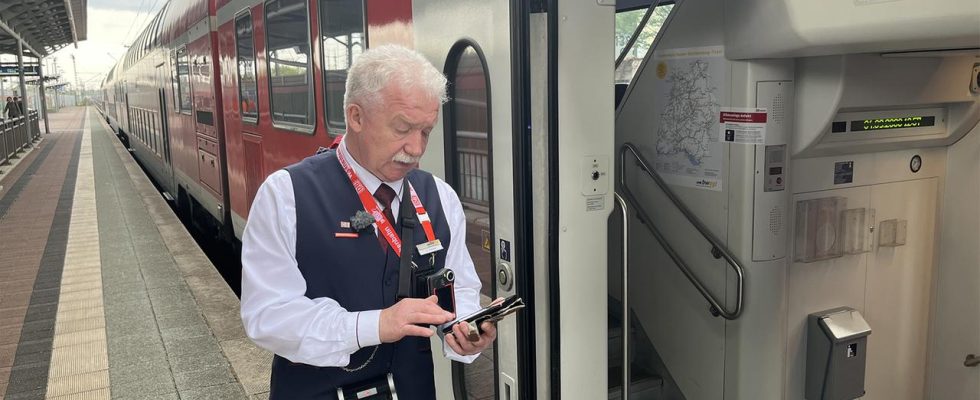In the middle
Train attendants are increasingly getting the frustration of train passengers – and often it is not just words. The railway is now using bodycams as a test – can they provide more protection?
“Anyone else got on here? The tickets please”: Valerie Fischer does his job with a lot of routine, he has been working for Deutsche Bahn for more than 30 years. He started out as a railroader, now he’s a train attendant.
Today he drives the Black Forest Express between Offenburg and Karlsruhe. The journey takes almost an hour. In the meantime, Fischer walks through the five wagons and checks the tickets. He is in charge of the train and is on his own in the event of conflict. And there are more and more of them. Railway employees are being attacked more and more frequently. There were more than 3,000 attacks on railway staff in 2022, around 21 percent more than in the previous year.
“I was gone for a while too”
It is often not just words, the train attendants are also physically attacked. Fischer has also experienced this: “A passenger pulled me and threw me on a seat. I was gone for a short time. That was cruel.”
That’s why Deutsche Bahn is testing the use of bodycams on the Black Forest route until the end of the year – to protect their staff. Today Fischer wears such a bodycam. He picked her up before the shift started, and now she’s hanging in a holder at chest height in the 64-year-old’s house.
On a small screen, passengers can see which section the camera is capturing. However, the recording only begins when Fischer finds himself in a threatening situation and presses a button on the page. “If things escalate, then I say to the passenger: I’ll make a video. I’m not allowed to turn on the camera beforehand,” explains the train attendant.
deterrence and evidence
If an attack actually occurs, the video footage is automatically sent to the police. They can then use the material as evidence to locate attackers. But it shouldn’t get that far in the first place: “Sometimes situations escalate out of nowhere. But when people see the camera, they withdraw immediately. That way I have more security,” reports Fischer.
He has been wearing the bodycam for over a month now and has had to use it a number of times. Like on this day: Two women don’t have a valid ticket with them and don’t want to pay the fine that is due. They refuse to show their IDs. Fischer has no other choice: “I’ll turn on the camera now and I’ll record it, okay? I can do that.”
But then it goes very quickly. Even before the train attendant triggers the camera, the two women show their ID and accept the fine.
Valerie Fischer feels safer with the camera.
Union calls for staff reinforcement
Are the body cams enough? “We’re not allowed to hold people down,” explains Fischer. Only the federal police are allowed to do that. That’s why it’s so important to take evidence with the bodycam. Colleagues have also been physically attacked, he says. “I always retire, just like I’ve been taught to do.” A situation often escalates within seconds. With the camera he now feels safer in such situations.
The body cams are not enough for the Union of German Locomotive Drivers (GDL). “If a bodycam is used, a second train attendant is also needed on the train,” demands Lutz Dächert from the GDL. But additional colleagues for Fischer are not in sight for the time being. Therefore he would like to keep his bodycam.
Fischer still has two years to go before he retires. By then, he hopes that bodycams will become the standard for all train attendants.

